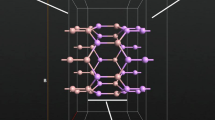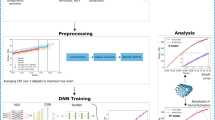Abstract
Context
The Adenine-based nanotube is theoretically designed, and its transmission spectra are investigated. The quantum-confined Adenine nanotube shows electronic transmission of the carrier at minimum stress. In this paper, the prediction of transmission spectra of the quantum-confined bio-molecular nanotube is investigated and deeply studied. Molecular level structure prediction and their electronic characterization can be possible with ab initio accuracy using a machine learning algorithmic approach. At the molecular level, it is difficult to predict quantum transmission spectra as these results are always hampered by the carrier backscattering effect. However, mostly these predictive models are available for intrinsic semi-conducting materials and other inorganic structures.
Methods
Machine learning algorithms are designed to predict the electronic properties of the nano-scale structure. This task is even more difficult when quantum-confined molecular arrangements are considered, whose transmission spectra are sensitive to the confinements applied. This paper presents an effective machine learning algorithms framework for predicting transmission spectra of quantum-confined nanotubes from their geometries. In this paper, we consider regression machine learning algorithms to find maximum accuracy with varying configurations and geometries to excerpt their atoms’ local environment information. The Hamiltonian components are then used to enable the utilization of the information to predict the electronic structure at any arbitrary sampling point or k-point. The theoretical basics introduced in this process help to capture and incorporate minor changes in quantum confinements into transmission spectra and provide the framework algorithm with more accuracy. This paper shows the ability to predict the accurate algorithmic models of the Adenine nanotube. In this framework, we have considered a tiny data set to achieve a rapid and reliable method for electronic structure determination and also propose the best algorithm for predictive model analysis.








Similar content being viewed by others
Data availability
All of the material is owned by the authors, and/or no permissions are required.
References
Wang Z, Ye S, Wang H, Huang Q, He J, Chang S (2022) Graph representation-based machine learning framework for predicting electronic band structures of quantum-confined nanostructures. Sci China Mater 65(11):3157–3170
Carleo G, Cirac I, Cranmer K, Daudet L, Schuld M, Tishby N, Zdeborová L (2019) Machine learning and the physical sciences. Rev Mod Phys 91(4):045002
Dral PO (2020) Quantum chemistry assisted by machine learning. Adv Quantum Chem 81:291–324
Westermayr J, Gastegger M, Schütt KT, Maurer RJ (2021) Perspective on integrating machine learning into computational chemistry and materials science. J Chem Phys 154(23):230903
Ragone M, Saray MT, Long L, Shahbazian-Yassar R, Mashayek F, Yurkiv V (2022) Deep learning for mapping element distribution of high-entropy alloys in scanning transmission electron microscopy images. Comput Mater Sci 201:110905
Ward L, Liu R, Krishna A, Hegde VI, Agrawal A, Choudhary A, Wolverton C (2017) Including crystal structure attributes in machine learning models of formation energies via Voronoi tessellations. Physical Review B 96(2):024104
Faber FA, Lindmaa A, Von Lilienfeld OA, Armiento R (2016) Machine learning energies of 2 million elpasolite (A B C 2 D 6) crystals. Phys Rev Lett 117(13):135502
Ghosh K, Stuke A, Todorović M, Jørgensen PB, Schmidt MN, Vehtari A, Rinke P (2019) Deep learning spectroscopy: neural networks for molecular excitation spectra. Adv Sci 6(9):1801367
Carrete J, Mingo N, Wang S, Curtarolo S (2014) Nanograined Half-Heusler semiconductors as advanced thermoelectrics: an ab initio high-throughput statistical study. Adv Funct Mater 24(47):7427–7432
Ju S, Shiga T, Feng L, Hou Z, Tsuda K, Shiomi J (2017) Designing nanostructures for phonon transport via Bayesian optimization. Phys Rev X 7(2):021024
Schütt KT, Glawe H, Brockherde F, Sanna A, Müller KR, Gross EK (2014) How to represent crystal structures for machine learning: towards fast prediction of electronic properties. Phys Rev B 89(20):205118
Seko A, Hayashi H, Nakayama K, Takahashi A, Tanaka I (2017) Representation of compounds for machine-learning prediction of physical properties. Phys Rev B 95(14):144110
Xue D, Balachandran PV, Hogden J, Theiler J, Xue D, Lookman T (2016) Accelerated search for materials with targeted properties by adaptive design. Nat Commun 7(1):1–9
Ghiringhelli LM, Vybiral J, Levchenko SV, Draxl C, Scheffler M (2015) Big data of materials science: critical role of the descriptor. Phys Rev Lett 114(10):105503
Von Lilienfeld OA, Ramakrishnan R, Rupp M, Knoll A (2015) Fourier series of atomic radial distribution functions: a molecular fingerprint for machine learning models of quantum chemical properties. Int J Quantum Chem 115(16):1084–1093
Carapezzi S, Boschetto G, Todri-Sanial A (2022) Capillary-force-driven self-assembly of carbon nanotubes: from ab initio calculations to modeling of self-assembly. Nanoscale Adv 4(19):4131–4137
Shah KA, Parvaiz MS, Dar GN, Misra P (2022) Carbon nanotube logic gates: an interplay of spin and light. J Appl Phys 131(20):204301
Kumanek B, Milowska KZ, Przypis Ł, Stando G, Matuszek K, MacFarlane D et al (2022) Doping engineering of single-walled carbon nanotubes by nitrogen compounds using basicity and alignment. ACS Appl Mater Interfaces 14(22):25861–25877
Singh S, Deb J, Sarkar U, Sharma S (2022) MoSe2/multiwalled carbon nanotube composite for ammonia sensing in natural humid environment. J Hazard Mater 435:128821
Dixit A, Gupta N (2021) A simplified surface potential based current model for gate-all-around carbon nanotube field effect transistor (GAA-CNFET). Int J Nanoelectr Mater 14:159–168
Dey D, De D, Ghaemi F, Ahmadian A, Abdullah LC (2019) Circuit level modeling of electrically doped adenine–thymine nanotube based field effect transistor. IEEE Access 8:6168–6176
Dey D, Roy P, De D (2017) Atomic scale modeling of electrically doped pin FET from adenine based single wall nanotube. J Mol Graph Model 76:118–127
Dey D, De D (2018) A first principle approach toward circuit level modeling of electrically doped gated diode from single wall thymine nanotube-like structure. Microsyst Technol 24:3107–3121
Author information
Authors and Affiliations
Contributions
DDR planned and wrote the manuscript. PR prepared the figures, and DD checked the manuscript and provided overall feedback. All the authors reviewed the manuscript.
Corresponding author
Ethics declarations
Ethical approval
Not applicable
Competing interests
The authors declare no competing interests.
Additional information
Publisher’s note
Springer Nature remains neutral with regard to jurisdictional claims in published maps and institutional affiliations.
Rights and permissions
Springer Nature or its licensor (e.g. a society or other partner) holds exclusive rights to this article under a publishing agreement with the author(s) or other rightsholder(s); author self-archiving of the accepted manuscript version of this article is solely governed by the terms of such publishing agreement and applicable law.
About this article
Cite this article
Roy, D.D., Roy, P. & De, D. Machine learning and DFT-based combined framework for predicting transmission spectra of quantum-confined bio-molecular nanotube. J Mol Model 29, 338 (2023). https://doi.org/10.1007/s00894-023-05741-y
Received:
Accepted:
Published:
DOI: https://doi.org/10.1007/s00894-023-05741-y




